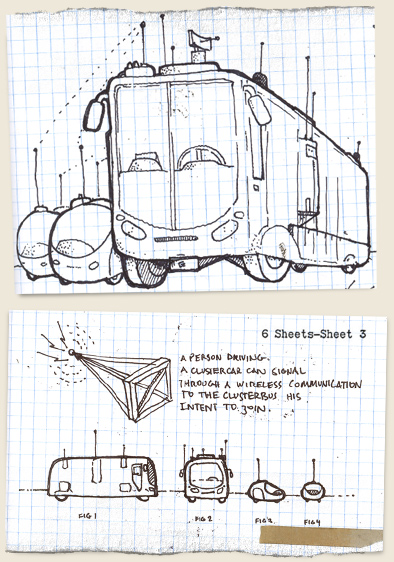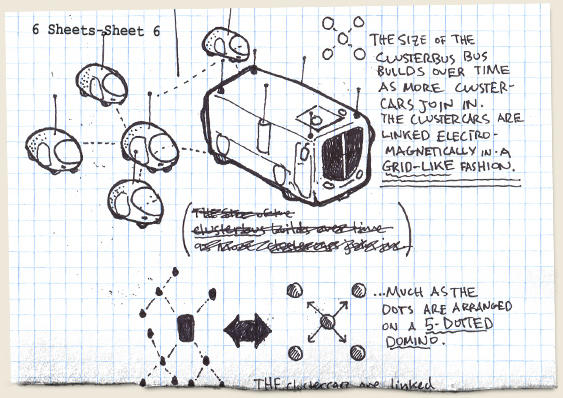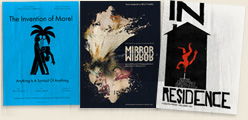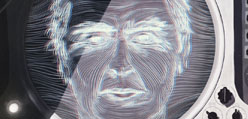The clusterbus is a mode of transport that brings together new advances in electromechanical engineering and mechanical swarm design to move people from place to place efficiently, saving time and energy without compromising freedom of movement.

Schematics by Hank Oatmeal
A clusterbus consists of as few as one and as many as 50 clustercars. Each clustercar is roughly identical, although variances in design and size are possible within the constraints of the system. At minimum, all clustercars must have an oblong, egg-like shape to accommodate reshuffling within the clusterbus and jettisoning at the point of exit. All clustercars must also be equipped with the hardware and software necessary to communicate with other clustercars and with the clusterbus driver. Clustercars must be all-electric, battery-powered vehicles.
The clusterbus begins with a clusterbus driver, an autonomous vehicle manned by a person who specializes in steering the clusterbus and managing its constituents. Ideally, clusterbus drivers are government-financed (they can be privately run, assuming they can find an effective way of charging for services) and drive a regular route between two distant points at regular intervals.
 ABOUT BLUEPRINTS
ABOUT BLUEPRINTSSUBMIT A BLUEPRINT
The clusterbus combines freedom of movement with all the environmental and congestion-stopping benefits of buses, trains and other modes of ground transportation.
Upon seeing a clusterbus driver, a person driving a clustercar — also an autonomous vehicle — can signal through a radio communication to the clusterbus driver his intent to join the clusterbus through a computer interface on his dashboard. At that point, electromagnets are activated on the left-rear and right-rear sides of the clusterbus driver, and the clustercar’s left-front and right-front magnets activate, too, allowing him to draw near and bind magnetically to the clusterbus driver on his left- or right-rear side.
Now that the clustercar is bound into the clusterbus, he gives over control of his vehicle to the clusterbus driver using the electromagnetic link established upon connection. The clustercar driver must now specify where he wishes to leave the cluster using his computer interface, which is equipped with a map that shows exit points. As a shortcut, he is also allowed to choose “next exit,” “next gas station” and so forth. He can even store pre-programmed routes, such as a daily commute, saving him the hassle of specifying his exact exit point every time.
At this point, the clusterbus contains two vehicles: the clusterbus driver and the clustercar. But more clustercars can join as they see the clusterbus forming on the road. The process of connecting additional cars is exactly the same as it is for connecting the first one; the clustercars are linked electromagnetically in a grid-like fashion, much as the dots are arranged on a five-dotted domino.

The size of the clusterbus builds over time as more clustercars join in. It may also reduce in size, of course, as clustercars reach their exit points.
While the clustercars are in the clusterbus, they draw power mainly from the batteries in the clusterbus driver, but they also use less energy individually through the efficiency of combined momentum. This advantage allows electrically powered clustercars to travel much further on a single charge than independent, non-clustering electric cars. Lack of range has been a key criticism of electric cars; clustercars excel in range.
When it comes time for a clustercar to exit the clusterbus, control algorithms in the clusterbus driver push the clustercar to the perimeter of the cluster and let it go — giving the clustercar’s occupants clear advance warning, of course. It then goes on its way independently, and the remaining cars in the cluster converge to replace the lost clustercar.
The clusterbus is a mode of public transport that combines freedom of movement — the lack of which has been the main drawback of more traditional ways of shuttling people around — with all the environmental and congestion-stopping benefits of buses, trains and other modes of ground transportation. It also leverages recent advances in the study of mechanized swarming and electromechanical engineering, while requiring little or no modification to existing road infrastructure and greatly extending the range of electric vehicles. It is the way forward.
ABOUT
BLUEPRINTS
A New York Moon “Blueprint” is essentially an idea encapsulated in a short amount of words or imagery.  It is something that could occur to as you ride the subway or right before you fall asleep. The Moon is interested in publishing re-imaginings of the city or world, and proposals that are as much thought experiments as possible creations. For example, if you think the intersection outside your house could be designed better or at least in a way more accomodating to human interaction, draw it and submit it, or photoshop it. On another plane, if you, in a fit of Fourierism, have a novel idea about to organize your building’s daily routine so as to inspire creativity and love, we are all ears and eyes. It is best, perhaps, to read a few blueprints to get a better understanding of how they work.
It is something that could occur to as you ride the subway or right before you fall asleep. The Moon is interested in publishing re-imaginings of the city or world, and proposals that are as much thought experiments as possible creations. For example, if you think the intersection outside your house could be designed better or at least in a way more accomodating to human interaction, draw it and submit it, or photoshop it. On another plane, if you, in a fit of Fourierism, have a novel idea about to organize your building’s daily routine so as to inspire creativity and love, we are all ears and eyes. It is best, perhaps, to read a few blueprints to get a better understanding of how they work.
Submit Blueprints to: blueprints@nymoon.com













